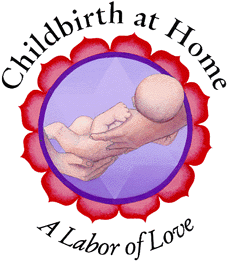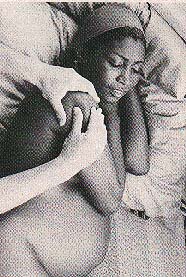
By Shelly Girard, B.S., C.M.T., L.M., C.P.M., M.P.H.

If you have questions about pregnancy massage, please E-mail:
or go to: www.pregnancymassage.net
Massage, the art of therapeutic bodywork, has been practiced from time immemorial by both ancient and primitive peoples. Concepts which linked the body to the mind and spirit were once discounted as "unscientific" in the west, and the human body came to be regarded as a sophisticated machine. Yet in the light of the development of modern psychology and a more sophisticated knowledge of anatomy and physiology, health care professionals are beginning to reexamine touch therapy. As we confront the challenge of understanding how personal growth, character, physical structure, and health and disease relate to one another, we begin to create a new matrix -- "the bodymind".* * Term coined by Ken Dychtwald in his book Bodymind
Bodymind is the concept that health and disease don't just happen to us, they are active processes reflecting psychological and somatic harmony. As more is learned in research on the brain, the connection between mind and illness becomes understandable. The brain masterminds or indirectly influences every function of the body: blood pressure, heart rate, immune responses and hormones. The old saying "name your poison" applies to the semantics and symbols of disease. People have long spoken of a "broken heart" as the symbol of a disappointing relationship: research now shows a connection between loneliness and heart disease!
Over the years, our bodies become walking autobiographies that tell friends and strangers alike of the minor stresses and strains of our lives. If one has an accident, distortions resulting from injury can become a permanent part of our body pattern. Our musculature reflects old anxieties- fear, depression, bravado, stoicism- locked into our bodies as patterns in our sensory-motor systems. Our body's tight patterns begin to contribute to our locked-in mental processes. For instance, just as the body is constricted by the mind's grief, the mind is constricted by the body's stubborn memory of what the mind used to feel.
The sum total of this is that massage has unlimited possibilities for human development from two different angles. On the one hand, based on physiological principles, massage can provide the means to relieve the incredible stress and strain to which we are subjected day after day in modern living. For those to whom pain and stiffness are a habitual way of life, bodywork can provide a means to experience how it feels to have a body that can breathe, stand and move more freely, unconstricted by tight muscles and not drained by energy-consuming tension. On the other hand, there are a diverse array of therapies that deeply massage, manipulate, loosen and change the body's neuromuscular system, its orientation to gravity, and its symmetry.
There is no other time in which bodywork can have as important an application than during pregnancy. When we begin to visualize pregnancy as far more than a physical state, and see it as a profound emotional, mental  and spiritual process, it is clear that massage can be of great benefit to the pregnant mother. Woman have long held the amazing ability to influence the state of their bodies with their thoughts and feelings, and conversely, to allow their physical appearance or state of health to dominate how they feel about themselves as individuals. How many of us have created an acne breakout when nervous about a new date, or allowed the "bad hair day" syndrome to taint an otherwise perfectly normal day with irritability and gloom.
and spiritual process, it is clear that massage can be of great benefit to the pregnant mother. Woman have long held the amazing ability to influence the state of their bodies with their thoughts and feelings, and conversely, to allow their physical appearance or state of health to dominate how they feel about themselves as individuals. How many of us have created an acne breakout when nervous about a new date, or allowed the "bad hair day" syndrome to taint an otherwise perfectly normal day with irritability and gloom.
During pregnancy and childbearing, the enormous influx of hormones combined with weight gain, altered body shape, and the normal biophysical and structural discomforts caused by increased blood volume and a shifting center of gravity, all contribute to many pregnant women feeling downright uncomfortable, emotionally and physically! Massage can provide an excellent means not only for relieving body stress, but also for helping her deal with emotional fears and concerns. When a woman feels integrated and healthy in her body and mind, she will manifest a more positive birth experience.
How is it possible that simply "rubbing" the skin can presume to live up to claims of being one of the most effective means to influence the structures and functions of body and mind? The skin is the largest sensory organ of the human body, arising in the human embryo from the same cell layers as the nervous system, the ectoderm. Ashley Montague writes in Touching:
- The surface area of the skin has an enormous number of sensory receptors receiving stimuli of heat, cold, touch, pressure, and pain. A piece of skin the size of a quarter contains more than 3 million cells, 100-340 sweat glands, 50 nerve endings and three feet of blood vessels. It is estimated that there are some 50 receptors/100 sq. mm., a total of 640,000 sensory receptors. The number of sensory fibers from the skin entering the spinal cord is well over half a million.
In a sense, the nervous system is part of the skin, or the skin is an external nervous system, conveying knowledge of the environment to the organism. In the evolution of the senses, the tactile system was the first system to come into being in all species. The sense most closely associated with the skin, the sense of touch, is the earliest to develop in the human embryo.
Touch means contact, a relationship with what lies outside our own periphery. For humans touch is of vital importance, giving reassurance, warmth, pleasure and vitality. It tells us that we are not alone. As infants, it is primarily through touch that we explore and make sense of the world; the loving touch of our parents is essential to our growth. The cuddling and stroking we receive in infancy helps us build a healthy image of ourselves and nurtures the feeling that we are accepted and loved.
Psychologists have demonstrated that our perception of how much we are touched relates to how we value ourselves, our self-esteem. Patients denied skin contact report feeling acutely isolated, cut off from the warmth of human touch- hence the concept of "solitary confinement" as the ultimate punishment. With the increased physiological and emotional stress of pregnancy, an occasional massage can be of significant benefit.
Some of the primary physical effects of bodywork are:
- Massage serves to heighten circulation to the skin by increasing blood flow to the veins and surface capillaries, promoting better cellular nutrition and elimination.
- Massage increases production of red and white blood cells, especially useful in cases of anemia.
- The work of the heart is lessened due to improved circulation.
- Massage stimulates the activity of sweat and oil glands creating more radiant and supple skin.
- Massage influences blood and lymph vessels by direct mechanical action, putting pressure on the vessel walls which propels the movement of blood, and stimulating the vasomotor nerves which control constriction and relaxation of blood vessels and determine the amount of blood reaching the area being massaged.
- Massage acts as a mechanical cleanser, pushing along lymph and hastening the elimination of wastes and toxic debris.
- Massage relaxes muscle spasms, improves muscle tone and elasticity, and helps prevent atrophy resulting from inactivity.
- Muscle tissue, tired by work or exercise, is restored more quickly as waste products of fatigue (i.e. lactic acid) are readily removed, and replacement nutrients replenished by increased circulation.
- Massage stretches connective tissue, and improves its circulation and nutrition, reducing the danger of fibrosis and preventing the formation of adhesions.
- Massage improves circulation and nutrition to joints.
Some of the psychological effects of bodywork are:
- Massage helps relieve muscle tension and corresponding mental tension.
- Deep tissue massage helps free up fascia (connective tissue) and muscles, allowing the body to assume a more integrated posture.
- By releasing chronically held trauma and reconnecting the natural flow and balance of the organism, touch therapy encourages growth and openness on all levels of functioning.
- Gentle stoking has a sedative affect on the nervous system, promoting deep relaxation.
- Allowing the intimacy of touch creates a state of trust and receptivity which facilitates clearer mental and emotional perception.
- Massage can assist the integration of emotional, mental or spiritual transformation on a cellular level.
- The sense of renewed health and vitality experienced following a bodywork session improves self esteem and consequently esteem for others.
Clearly then, massage is particularly beneficial for expectant mothers as it not only promotes physical well being, but also helps prepare women psychologically and spiritually for the process of labor and birth. Although a professional massage may be a wonderful way to experience bodywork, it is by no means the only way. During pregnancy, friends or partners can experiment with different strokes and pressures to help relieve some of the natural stress and tensions of the expectant mother. There are many excellent books giving basic instruction in technique for the novice. The key is to remain sensitive at all times to her needs, and to allow her to communicate where and how she is comfortable being touched. Be creative, open and loving!